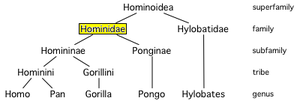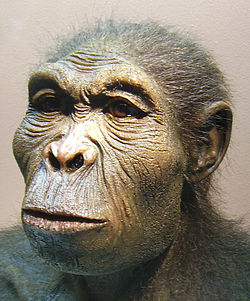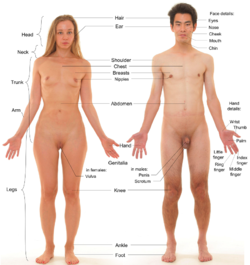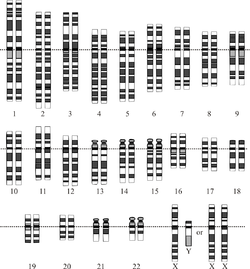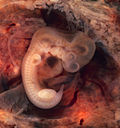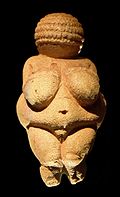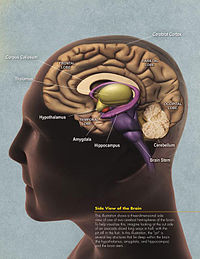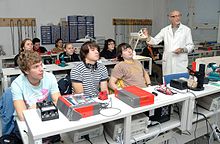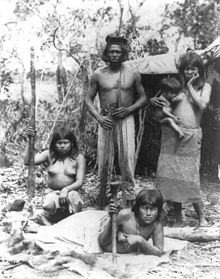
Human
Background to the schools Wikipedia
This Wikipedia selection is available offline from SOS Children for distribution in the developing world. A good way to help other children is by sponsoring a child
| Human Temporal range: 0.195–0Ma Pleistocene – Recent |
|
|---|---|
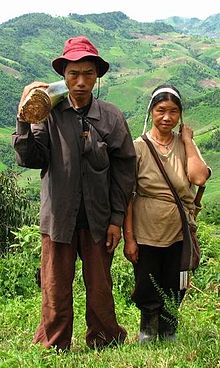 |
|
| A man and a woman from Southeast Asia | |
| Conservation status | |
 Least Concern ( IUCN 3.1) |
|
| Scientific classification |
|
| Kingdom: | Animalia |
| Phylum: | Chordata |
| Class: | Mammalia |
| Order: | Primates |
| Family: | Hominidae |
| Tribe: | Hominini |
| Genus: | Homo |
| Species: | H. sapiens |
| Binomial name | |
| Homo sapiens Linnaeus, 1758 |
|
| Subspecies | |
|
† Homo sapiens idaltu White et al., 2003 |
|
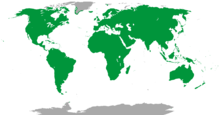 |
|
| Range of Homo sapiens (green) | |
| Synonyms | |
|
Species synonymy
|
|
Humans (Homo sapiens) are primates of the family Hominidae, and the only extant species of the genus Homo. Humans are characterized by having a large brain relative to body size, with a particularly well developed neocortex, prefrontal cortex and temporal lobes, making them capable of abstract reasoning, language, introspection, problem solving and culture through social learning. This mental capability, combined with an adaptation to bipedal locomotion that frees the hands for manipulating objects, has allowed humans to make far greater use of tools than any other species. Humans are the only extant species known to build fires and cook their food, as well as the only known species to clothe themselves and create and use numerous other technologies and arts. The scientific study of humans is the discipline of anthropology.
Humans are uniquely adept at utilizing systems of symbolic communication such as language and art for self-expression, the exchange of ideas, and organization. Humans create complex social structures composed of many cooperating and competing groups, from families and kinship networks to states. Social interactions between humans have established an extremely wide variety of values, social norms, and rituals, which together form the basis of human society. Humans are noted for their desire to understand and influence their environment, seeking to explain and manipulate phenomena through science, philosophy, mythology, and religion.
Homo sapiens originated in Africa, where it reached anatomical modernity about 200,000 years ago and began to exhibit full behavioural modernity around 50,000 years ago. The human lineage diverged from the last common ancestor with its closest living relative, the chimpanzee, some five million years ago, evolving into the Australopithecines and eventually the genus Homo. The first Homo species to move out of Africa was Homo erectus, the African variety of which, together with Homo heidelbergensis, is considered to be the immediate ancestor of modern humans. Homo sapiens proceeded to colonize the continents, arriving in Eurasia 125,000-60,000 years ago, Australia around 40,000 years ago, the Americas around 15,000 years ago, and remote islands such as Hawaii, Easter Island, Madagascar, and New Zealand between the years AD 300 and 1280.
Humans began to practice sedentary agriculture about 12,000 years ago, domesticating plants and animals which allowed for the growth of civilization. Humans subsequently established various forms of government, religion, and culture around the world, unifying people within a region and leading to the development of states and empires. The rapid advancement of scientific and medical understanding in the 19th and 20th centuries led to the development of fuel-driven technologies and improved health, causing the human population to rise exponentially. With individuals widespread in every continent except Antarctica, humans are a cosmopolitan species, and by 2012, their population was estimated to be around 7 billion.
Etymology and definition
With the discovery and study of fossil ancestors of modern humans the meaning of the word "human" changed, as the previously clear boundary between human and ape blurred, now encompassing multiple species. Today in scientific usage "human" may refer to any member of the genus Homo. Furthermore within Homo sapiens, there is a distinction between anatomically modern Homo sapiens and Archaic Homo sapiens, the earliest fossil members of the species. Sometimes groups such as the Neanderthals are classified as a subspecies of Homo sapiens - Homo sapiens neanderthalensis. However, in everyday usage, and in this article, the word "human" generally refers to the only extant species of the genus - anatomically and behaviorally modern Homo sapiens. The open question about possible extinct subspecies will be briefly covered. Fossil humans are covered in the article " Homo", and in the articles about individual species of the genus.
The English adjective human is a Middle English loanword from Old French humain, ultimately from Latin hūmānus, the adjective form of homō "man". The word's use as a noun (with a plural: humans) dates to the 16th century. The native English term man can refer to the species generally (a synonym for mankind), and could formerly refer to specific individuals of either sex. The latter use is now obsolete. Generic uses of the term "man" are declining, in favour of reserving it for referring specifically to adult males. The word is from Proto-Germanic * mannaz, from a Proto-Indo-European (PIE) root *man-.
The species binomial Homo sapiens was coined by Carl Linnaeus in his 18th century work Systema Naturae, and he himself is the lectotype specimen. The generic name Homo is a learned 18th century derivation from Latin homō "man", ultimately "earthly being" ( Old Latin hemō, a cognate to Old English guma "man", from PIE *dʰǵʰemon-, meaning 'earth' or 'ground'). The species-name sapiens means "wise" or "sapient". Note that the Latin word homo refers to humans of either gender, and that sapiens is the singular form (there is no word sapien).
History
Evolution
Scientific study of human evolution studies the development of the genus Homo, reconstructing the evolutionary divergence of the human lineage from other hominins (shared ancestors of humans and chimpanzees), hominids (great apes) and primates. Modern humans are defined as belonging to the species Homo sapiens, specifically to the single extant subspecies Homo sapiens sapiens.
Evidence from molecular biology
The closest living relatives of humans are chimpanzees (genus Pan) and gorillas (genus Gorilla). With the sequencing of both the human and chimpanzee genome, current estimates of similarity between human and chimpanzee DNA sequences range between 95% and 99%. By using the technique called a molecular clock which estimates the time required for the number of divergent mutations to accumulate between two lineages, the approximate date for the split between lineages can be calculated. The gibbons ( Hylobatidae) and orangutans (genus Pongo) were the first groups to split from the line leading to the humans, then gorillas (genus Gorilla) followed by the chimpanzees and bonobos (genus Pan). The splitting date between human and chimpanzee lineages is placed around 4-8 million years ago during the late Miocene epoch.
Evidence from the fossil record
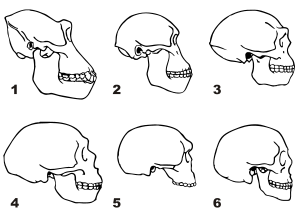
There is little fossil evidence for the divergence of the gorilla, chimpanzee and hominin lineages. The earliest fossils that have been proposed as members of the hominin lineage are Sahelanthropus tchadensis dating from 7 million years ago, and Orrorin tugenensis dating from 5.7 million years ago and Ardipithecus kadabba dating to 5.6 million years ago. Each of these have been argued to be a bipedal ancestor of later hominins, but in each cases the claims have been contested. It is also possible that either of these species are ancestors of another branch of African apes, or that they represent a shared ancestor between hominins and other apes. The question of the relation between these early fossil species and the hominin lineage is still to be resolved. From these early species the Australopithecines arose around 4 million years ago diverged into robust (also called Paranthropus) and gracile branches, one of which (possibly A. garhi) went on to become ancestors of the genus Homo.
The earliest members of the genus Homo are Homo habilis which evolved around 2.3 million years ago. Homo habilis is the first species for which we have positive evidence of use of stone tools. The brains of these early hominins were about the same size as that of a chimpanzee, and their main adaptation was bipedalism as an adaptation to terrestrial living. During the next million years a process of encephalization began, and with the arrival of Homo erectus in the fossil record, cranial capacity had doubled. Homo erectus were the first of the hominina to leave Africa, and these species spread through Africa, Asia, and Europe between 1.3 to 1.8 million years ago. One population of H. erectus, also sometimes classified as a separate species Homo ergaster, stayed in Africa and evolved into Homo sapiens. It is believed that these species were the first to use fire and complex tools. The earliest transitional fossils between H. ergaster/erectus and archaic humans are from Africa such as Homo rhodesiensis, but seemingly transitional forms are also found at Dmanisi, Georgia. These descendants of African H. erectus spread through Eurasia from ca. 500,000 years ago evolving into H. antecessor, H. heidelbergensis and H. neanderthalensis. The earliest fossils of anatomically modern humans are from the Middle Paleolithic, about 200,000 years ago such as the Omo remains of Ethiopia and the fossils of Herto sometimes classified as Homo sapiens idaltu. Later fossils of archaic Homo sapiens from Skhul in Israel and Southern Europe begin around 90,000 years ago.
Anatomical adaptations
Human evolution is characterized by a number of morphological, developmental, physiological, and behavioural changes that have taken place since the split between the last common ancestor of humans and chimpanzees. The most significant of these adaptations are 1. bipedalism, 2. increased brain size, 3. lengthened ontogeny (gestation and infancy), 4. decreased sexual dimorphism. The relationship between all these changes is the subject of ongoing debate. Other significant morphological changes included the evolution of a power and precision grip, a change first occurring in H. erectus.
Bipedalism is the basic adaption of the Hominin line, and it is considered the main cause behind a suite of skeletal changes shared by all bipedal hominins. The earliest bipedal Hominin is considered to be either Sahelanthropus or Orrorin, with Ardipithecus, a full bipedal, coming somewhat later. The knuckle walkers, the gorilla and chimpanzee, diverged around the same time, and either Sahelanthropus or Orrorin may be our last shared ancestor with those. The early bipedals eventually evolved into the Australopithecines and later the genus Homo. There are several theories of the adaptational value of bipedalism. It is possible that bipedalism was favored because it freed up the hands for reaching and carrying food, because it saved energy during locomotion, because it enabled long distance running and hunting, or as a strategy for avoiding hyperthermia by reducing the surface exposed to direct sun.
The human species developed a much larger brain than that of other primates – typically 1,330 cc in modern humans, over twice the size of that of a chimpanzee or gorilla. The pattern of encephalization started with Homo habilis which at approximately 600 cc had a brain slightly larger than chimpanzees, and continued with Homo erectus (800-1100 cc), and reached a maximum in Neanderthals with an average size of 1200-1900cc, larger even than Homo sapiens. The pattern of human postnatal brain growth differs from that of other apes ( heterochrony), and allows for extended periods of social learning and language acquisition in juvenile humans. However, the differences between the structure of human brains and those of other apes may be even more significant than differences in size. The increase in volume over time has affected different areas within the brain unequally - the temporal lobes, which contain centers for language processing have increased disproportionately, as has the prefrontal cortex which has been related to complex decision making and moderating social behaviour. Encephalization has been tied to an increasing emphasis on meat in the diet, or with the development of cooking, and it has been proposed that intelligence increased as a response to an increased necessity for solving social problems as human society became more complex.
The reduced degree of sexual dimorphism is primarily visible in the reduction of the male canine tooth relative to other ape species (except gibbons). Another important physiological change related to sexuality in humans was the evolution of hidden estrus. Humans are the only ape in which the female is fertile year round, and in which no special signals of fertility are produced by the body (such as genital swelling during estrus). Nonetheless humans retain a degree of sexual dimorphism in the distribution of body hair and subcutaneous fat, and in the overall size, males being around 25% larger than females. These changes taken together have been interpreted as a result of an increased emphasis on pair bonding as a possible solution to the requirement for increased parental investment due to the prolonged infancy of offspring.
Rise of Homo sapiens
By the beginning of the Upper Paleolithic period (50,000 BP (Before Present)), full behavioural modernity, including language, music and other cultural universals had developed. As modern humans spread out from Africa they encountered other hominids such as Homo neanderthalensis and the so-called Denisovans, who may have evolved from populations of Homo erectus that had left Africa already around 2 million years ago. The nature of interaction between early humans and these sister species has been a long standing source of controversy, the question being whether humans replaced these earlier species or whether they were in fact similar enough to interbreed, in which case these earlier populations may have contributed genetic material to modern humans. Recent studies of the Human and Neanderthal genomes suggest gene flow between archaic Homo sapiens and Neanderthals and Denisovans.
This migration out of Africa is estimated to have begun about 70,000 years BP. Modern humans subsequently spread globally, replacing earlier hominins (either through competition or hybridization). They inhabited Eurasia and Oceania by 40,000 years BP, and the Americas at least 14,500 years BP.
Transition to civilization
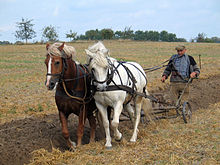
Until c. 10,000 years ago, humans lived as hunter-gatherers. They generally lived in small nomadic groups known as band societies. The advent of agriculture prompted the Neolithic Revolution, when access to food surplus led to the formation of permanent human settlements, the domestication of animals and the use of metal tools for the first time in history. Agriculture encouraged trade and cooperation, and led to complex society. Because of the significance of this date for human society, it is the epoch of the Holocene calendar or Human Era.
About 6,000 years ago, the first proto-states developed in Mesopotamia, Egypt's Nile Valley and the Indus Valley. Military forces were formed for protection, and government bureaucracies for administration. States cooperated and competed for resources, in some cases waging wars. Around 2,000–3,000 years ago, some states, such as Persia, India, China, Rome, and Greece, developed through conquest into the first expansive empires. Ancient Greece was the seminal civilization that laid the foundations of Western culture, being the birthplace of Western philosophy, democracy, major scientific and mathematical advances, the Olympic Games, Western literature and historiography, as well as Western drama, including both tragedy and comedy. Influential religions, such as Judaism, originating in West Asia, and Hinduism, originating in South Asia, also rose to prominence at this time.
The late Middle Ages saw the rise of revolutionary ideas and technologies. In China, an advanced and urbanized society promoted innovations and sciences, such as printing and seed drilling. In India, major advancements were made in mathematics, philosophy, religion and metallurgy. The Islamic Golden Age saw major scientific advancements in Muslim empires. In Europe, the rediscovery of classical learning and inventions such as the printing press led to the Renaissance in the 14th and 15th centuries. Over the next 500 years, exploration and colonialism brought great parts of the world under European control, leading to later struggles for independence. The Scientific Revolution in the 17th century and the Industrial Revolution in the 18th–19th centuries promoted major innovations in transport, such as the railway and automobile; energy development, such as coal and electricity; and government, such as representative democracy and Communism.
With the advent of the Information Age at the end of the 20th century, modern humans live in a world that has become increasingly globalized and interconnected. As of 2010, almost 2 billion humans are able to communicate with each other via the Internet, and 3.3 billion by mobile phone subscriptions.
Although interconnection between humans has encouraged the growth of science, art, discussion, and technology, it has also led to culture clashes and the development and use of weapons of mass destruction. Human civilization has led to environmental destruction and pollution significantly contributing to the ongoing mass extinction of other forms of life called the holocene extinction event, which may be further accelerated by global warming in the future.
Habitat and population
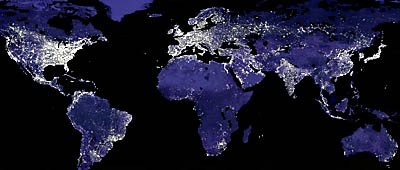
Early human settlements were dependent on proximity to water and, depending on the lifestyle, other natural resources used for subsistence, such as populations of animal prey for hunting and arable land for growing crops and grazing livestock. But humans have a great capacity for altering their habitats by means of technology, through irrigation, urban planning, construction, transport, manufacturing goods, deforestation and desertification. Deliberate habitat alteration is often done with the goals of increasing material wealth, increasing thermal comfort, improving the amount of food available, improving aesthetics, or improving ease of access to resources or other human settlements. With the advent of large-scale trade and transport infrastructure, proximity to these resources has become unnecessary, and in many places, these factors are no longer a driving force behind the growth and decline of a population. Nonetheless, the manner in which a habitat is altered is often a major determinant in population change.
Technology has allowed humans to colonize all of the continents and adapt to virtually all climates. Within the last century, humans have explored Antarctica, the ocean depths, and outer space, although large-scale colonization of these environments is not yet feasible. With a population of over seven billion, humans are among the most numerous of the large mammals. Most humans (61%) live in Asia. The remainder live in the Americas (14%), Africa (14%), Europe (11%), and Oceania (0.5%).
Human habitation within closed ecological systems in hostile environments, such as Antarctica and outer space, is expensive, typically limited in duration, and restricted to scientific, military, or industrial expeditions. Life in space has been very sporadic, with no more than thirteen humans in space at any given time. Between 1969 and 1972, two humans at a time spent brief intervals on the Moon. As of April 2013, no other celestial body has been visited by humans, although there has been a continuous human presence in space since the launch of the initial crew to inhabit the International Space Station on October 31, 2000. However, other celestial bodies have been visited by human-made objects.
Since 1800, the human population has increased from one billion to over seven billion. In 2004, some 2.5 billion out of 6.3 billion people (39.7%) lived in urban areas, and this percentage is expected to continue to rise throughout the 21st century. In February 2008, the U.N. estimated that half the world's population would live in urban areas by the end of the year. Problems for humans living in cities include various forms of pollution and crime, especially in inner city and suburban slums.
Humans have had a dramatic effect on the environment. As humans are rarely preyed upon, except by other humans for a variety of reasons, they have been described as apex or superpredators. Currently, through land development, combustion of fossil fuels, and pollution, humans are thought to be the main contributor to global climate change. If this continues at its current rate it is predicted that climate change will wipe out half of all species over the next century.
Biology
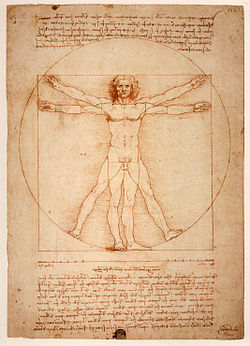
Anatomy and physiology
Human body types vary substantially. Although body size is largely determined by genes, it is also significantly influenced by environmental factors such as diet and exercise. The average height of an adult human is 1.4 m (4 ft 7 in) to 1.9 m (6 ft 3 in) tall, although this varies significantly from place to place and depending on ethnic origin. The average mass of an adult human is 54–64 kg (120–140 lbs) for females and 76–83 kg (168–183 lbs) for males. Weight can also vary greatly (e.g. obesity).
Although humans appear hairless compared to other primates, with notable hair growth occurring chiefly on the top of the head, underarms and pubic area, the average human has more hair follicles on his or her body than the average chimpanzee. The main distinction is that human hairs are shorter, finer, and less heavily pigmented than the average chimpanzee's, thus making them harder to see. Humans, like other primates, have sweat glands, better enabling them to conserve energy in tropical environments.
The hue of human skin and hair is determined by the presence of pigments called melanins. Human skin hues can range from dark brown to pale pink, or even nearly white or colorless, such as in cases of Albinism. Human hair ranges from white to brown to red to most commonly black. This depends on the amount of melanin (an effective sun blocking pigment) in the skin and hair, with hair melanin concentrations in hair fading with increased age, leading to grey or even white hair. Most researchers believe that skin darkening was an adaptation that evolved as a protection against ultraviolet solar radiation, which also helps balancing folate, which is destroyed by ultraviolet radiation, and vitamin D, which requires sunlight to form. The skin pigmentation of contemporary humans is clinally distributed across the planet, and in general correlates with the level of ultraviolet radiation. Human skin also has a capacity to darken ( sun tanning) in response to exposure to ultraviolet radiation. Humans tend to be physically weaker than other similarly sized primates.
The construction of the human pelvis differs from other primates, as do the toes. As a result, humans are slower for short distances than most other animals, but are among the best long-distance runners in the animal kingdom. Humans' thinner body hair and more productive sweat glands also help avoid heat exhaustion while running for long distances. A trade-off for these advantages of the modern human pelvis is that childbirth is more difficult and dangerous, especially given the larger head size of human babies compared to other primates. This means that human babies must turn around as they pass through the birth canal which other primates do not do, and it makes humans the only species in which females require help from their conspecifics to reduce the risks of birthing.
The dental formula of Humans is:  . Humans have proportionately shorter palates and much smaller teeth than other primates. They are the only primates to have short, relatively flush canine teeth. Humans have characteristically crowded teeth, with gaps from lost teeth usually closing up quickly in young individuals. Humans are gradually losing their wisdom teeth, with some individuals having them congenitally absent.
. Humans have proportionately shorter palates and much smaller teeth than other primates. They are the only primates to have short, relatively flush canine teeth. Humans have characteristically crowded teeth, with gaps from lost teeth usually closing up quickly in young individuals. Humans are gradually losing their wisdom teeth, with some individuals having them congenitally absent.
Genetics
Like all mammals humans are a diploid eukaryotic species. Each somatic cell has two sets of 23 chromosomes, each set received from one parent, gametes have only one set of chromosomes which is a mixture of the two parental sets. Among the 23 chromosomes there are 22 pairs of autosomes and one pair of sex chromosomes. Like other mammals, humans have an XY sex-determination system, so that females have the sex chromosomes XX and males have XY.
One human genome was sequenced in full in 2003, and currently efforts are being made to achieve a sample of the genetic diversity of the species (see International HapMap Project). By present estimates, humans have approximately 22,000 genes. The variation in human DNA is minute compared to that of other species, possibly suggesting a population bottleneck during the Late Pleistocene (ca. 100,000 years ago), in which the human population was reduced to a small number of breeding pairs. Nucleotide diversity is based on single mutations called single nucleotide polymorphisms (SNPs). The nucleotide diversity between humans is about 0.1%, which is 1 difference per 1,000 base pairs. A difference of 1 in 1,000 nucleotides between two humans chosen at random amounts to approximately 3 million nucleotide differences since the human genome has about 3 billion nucleotides. Most of these SNPs are neutral but some (about 3 to 5%) are functional and influence phenotypic differences between humans through alleles.
By comparing the parts of the genome that are not under natural selection and which therefore accumulate mutations at a fairly steady rate, it is possible to reconstruct a genetic tree incorporating the entire human species since the last shared ancestor. Each time a certain mutation ( Single nucleotide polymorphism) appears in an individual and is passed on to his or her descendants a haplogroup is formed including all of the descendants of the individual who will also carry that mutation. By comparing mitochondrial DNA which is inherited only from the mother, geneticists have concluded that the last female common ancestor whose genetic marker is found in all modern humans, the so-called mitochondrial Eve, must have lived around 200,000 years ago.
The forces of natural selection have continued to operate on human populations, with evidence that certain regions of the genome display directional selection in the past 15,000 years.
Life cycle
As with other mammals, human reproduction takes place as internal fertilization by sexual intercourse. Upon fertilization and implantation, gestation then occurs within the female's uterus.
The zygote divides inside the female's uterus to become an embryo, which over a period of 38 weeks (9 months) of gestation becomes a fetus. After this span of time, the fully grown fetus is birthed from the woman's body and breathes independently as an infant for the first time. At this point, most modern cultures recognize the baby as a person entitled to the full protection of the law, though some jurisdictions extend various levels of personhood earlier to human fetuses while they remain in the uterus.
Compared with other species, human childbirth is dangerous. Painful labors lasting 24 hours or more are not uncommon and sometimes lead to the death of the mother, the child or both. This is because of both the relatively large fetal head circumference and the mother's relatively narrow pelvis. The chances of a successful labor increased significantly during the 20th century in wealthier countries with the advent of new medical technologies. In contrast, pregnancy and natural childbirth remain hazardous ordeals in developing regions of the world, with maternal death rates approximately 100 times greater than in developed countries.
In developed countries, infants are typically 3–4 kg (6–9 pounds) in weight and 50–60 cm (20–24 inches) in height at birth. However, low birth weight is common in developing countries, and contributes to the high levels of infant mortality in these regions. Helpless at birth, humans continue to grow for some years, typically reaching sexual maturity at 12 to 15 years of age. Females continue to develop physically until around the age of 18, whereas male development continues until around age 21. The human life span can be split into a number of stages: infancy, childhood, adolescence, young adulthood, adulthood and old age. The lengths of these stages, however, have varied across cultures and time periods. Compared to other primates, humans experience an unusually rapid growth spurt during adolescence, where the body grows 25% in size. Chimpanzees, for example, grow only 14%, with no pronounced spurt. The presence of the growth spurt is probably necessary to keep children physically small until they are psychologically mature. Humans are one of the few species in which females undergo menopause. It has been proposed that menopause increases a woman's overall reproductive success by allowing her to invest more time and resources in her existing offspring and/or their children (the grandmother hypothesis), rather than by continuing to bear children into old age.
There are significant differences in life expectancy around the world. The developed world is generally aging, with the median age around 40 years. In the developing world the median age is between 15 and 20 years. Life expectancy at birth in Hong Kong is 84.8 years for a female and 78.9 for a male, while in Swaziland, primarily because of AIDS, it is 31.3 years for both sexes. While one in five Europeans is 60 years of age or older, only one in twenty Africans is 60 years of age or older. The number of centenarians (humans of age 100 years or older) in the world was estimated by the United Nations at 210,000 in 2002. At least one person, Jeanne Calment, is known to have reached the age of 122 years; higher ages have been claimed but they are not well substantiated. Worldwide, there are 81 men aged 60 or older for every 100 women of that age group, and among the oldest, there are 53 men for every 100 women.
Diet

Humans are omnivorous, capable of consuming a wide variety of plant and animal material. Varying with available food sources in regions of habitation, and also varying with cultural and religious norms, human groups have adopted a range of diets, from purely vegetarian to primarily carnivorous. In some cases, dietary restrictions in humans can lead to deficiency diseases; however, stable human groups have adapted to many dietary patterns through both genetic specialization and cultural conventions to use nutritionally balanced food sources. The human diet is prominently reflected in human culture, and has led to the development of food science.
Until the development of agriculture approximately 10,000 years ago, Homo sapiens employed a hunter-gatherer method as their sole means of food collection. This involved combining stationary food sources (such as fruits, grains, tubers, and mushrooms, insect larvae and aquatic mollusks) with wild game, which must be hunted and killed in order to be consumed. It has been proposed that humans have used fire to prepare and cook food since the time of Homo erectus. Around ten thousand years ago, humans developed agriculture, which substantially altered their diet. This change in diet may also have altered human biology; with the spread of dairy farming providing a new and rich source of food, leading to the evolution of the ability to digest lactose in some adults. Agriculture led to increased populations, the development of cities, and because of increased population density, the wider spread of infectious diseases. The types of food consumed, and the way in which they are prepared, has varied widely by time, location, and culture.
In general, humans can survive for two to eight weeks without food, depending on stored body fat. Survival without water is usually limited to three or four days. About 36 million humans die every year from causes directly or indirectly related to hunger. Childhood malnutrition is also common and contributes to the global burden of disease. However global food distribution is not even, and obesity among some human populations has increased rapidly, leading to health complications and increased mortality in some developed, and a few developing countries. Worldwide over one billion people are obese, while in the United States 35% of people are obese, leading to this being described as an " obesity epidemic". Obesity is caused by consuming more calories than are expended, so excessive weight gain is usually caused by a combination of an energy-dense high fat diet and insufficient exercise.
Biological variation
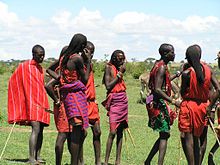
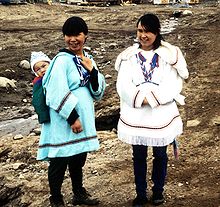
Most current genetic and archaeological evidence supports a recent single origin of modern humans in East Africa with first migrations placed at 60,000 years ago. Current genetic studies have demonstrated that humans on the African continent are the most genetically diverse. However, compared to the other great apes, human gene sequences are remarkably homogeneous.
Nonetheless, there is important biological variation in the human species — with traits such as skin color, eye color, hair colour and texture, height and build, and cranial features varying clinally across the globe. Those aspects of genetic variation that gives clue to human evolutionary history, or which are relevant for medical research have received particular attention. For example the genes that cause adult humans to be able to digest lactose are present in high frequencies in population that have long histories of cattle domestication, suggesting natural selection having favored that gene in populations that depend on cow milk. Some hereditary diseases such as Sickle cell anaemia are frequent in populations from areas in which Malaria has been endemic throughout history — it is believed that the same gene causes increased resistance to Malaria among those who are unaffected carriers. Similarly populations that have inhabited specific climates such as arctic or tropical regions or high altitudes, tend to have developed specific phenotypes that are beneficial for conserving energy in those environments — short stature and stocky build in cold regions, tall and lanky in hot regions, and with high lung capacities in high altitudes. Similarly variation in skin colour varies clinally with darker colors around the equator where the added protection from the sun is thought to give an evolutionary advantage, and lighter skin tones closer to the poles where there is less sunlight and the lighter colored skin improves Vitamin D synthesis.
Today it is possible to determine, by genetic analysis, the geographic ancestry of a person and the degree of ancestry from each region. Such analyses can pinpoint the migrational history of a person's ancestors with a high degree of accuracy. Often, due to practices of group endogamy, allele frequencies cluster locally around kin groups and lineages, or by national, cultural or linguistic boundaries, giving a detailed degree of correlation between genetic clusters and population groups when considering many alleles simultaneously.
Race

There is considerable biological variation in between human populations across the globe, resulting in fairly variable phenotypes. Traditionally human phenotypical variation has been described as breaking down into large continental races, characterized by easily definable traits. Humans were then classified into one of four or five phenotypical groups often based on skin colour, hair texture, and facial anatomy, and which were matched to a continent with which each group were associated. Often racial classification of humans was described in terms of essential characteristics, and came to serve as a way of naturalizing social and cultural stereotypes about racial groups, in turn justifying or motivating different forms of racism. As the study of human biological variation advanced it became clear that most variation is clinally distributed and blends gradually from one area to the next, with no clear boundaries between continents, additionally different traits have different clinal distributions. This realization made many anthropologists and biologists abandon the idea of major human races, instead describing biological variation in terms of populations and clinally distributed traits.
Today there is no scientific consensus on the biological relevance of race. While biological characteristics of an individual can give many clues about the geographical origin of their ancestors, anthropologists generally reject the notion of human "race" as a biological classification scheme. Instead they see it as a set of social constructions that map onto, but partly obscures, biological variation. Most anthropologists also maintain that the term "race" tacitly assumes that races are clearly bounded groups with essential characteristics, often ordered hierarchically and used to justify social inequality. An opposing view has it that it is possible to talk about "races" without making essentialist or hierarchical assumptions, and some biologists and many forensic scientists use the word race to describe biological variation associated with continental ancestry. It is generally agreed upon that certain genetic traits, including some common illnesses, correlate with genetic ancestry from specific regions, and genetic ancestry as determined by racial identification is becoming an increasingly common tool for risk assessment in medicine.
The use of the term "race" to mean something like " subspecies" among humans is obsolete; Homo sapiens has no existing subspecies (with the exception of Homo sapiens sapiens, the subspecies which includes all existing humans). In its modern scientific connotation, the term is not applicable to a species as genetically homogeneous as the human one, as stated in the declaration on race (UNESCO 1950, re-ratified 1978). Genetic studies have substantiated the absence of clear biological borders; thus the term "race" is rarely used in scientific terminology, either in biological anthropology and in human genetics. What in the past had been defined as "races"—whites, blacks, or Asians—are now defined as "ethnic groups" or "populations", in correlation with the field (sociology, anthropology, genetics) in which they are considered.
Psychology
The human brain, the focal point of the central nervous system in humans, controls the peripheral nervous system. In addition to controlling "lower", involuntary, or primarily autonomic activities such as respiration and digestion, it is also the locus of "higher" order functioning such as thought, reasoning, and abstraction. These cognitive processes constitute the mind, and, along with their behavioural consequences, are studied in the field of psychology.
Generally regarded as more capable of these higher order activities, the human brain is believed to be more "intelligent" in general than that of any other known species. While some non-human species are capable of creating structures and using simple tools—mostly through instinct and mimicry—human technology is vastly more complex, and is constantly evolving and improving through time.
Sleep and dreaming
Humans are generally diurnal. The average sleep requirement is between seven and nine hours per day for an adult and nine to ten hours per day for a child; elderly people usually sleep for six to seven hours. Having less sleep than this is common among humans, even though sleep deprivation can have negative health effects. A sustained restriction of adult sleep to four hours per day has been shown to correlate with changes in physiology and mental state, including reduced memory, fatigue, aggression, and bodily discomfort. During sleep humans dream. In dreaming humans experience sensory images and sounds, in a sequence which the dreamer usually perceives more as an apparent participant than as an observer. Dreaming is stimulated by the pons and mostly occurs during the REM phase of sleep.
Consciousness and thought
Humans are one of the relatively few species to have sufficient self-awareness to recognize themselves in a mirror. Already at 18 months, most human children are aware that the mirror image is not another person.
The human brain perceives the external world through the senses, and each individual human is influenced greatly by his or her experiences, leading to subjective views of existence and the passage of time. Humans are variously said to possess consciousness, self-awareness, and a mind, which correspond roughly to the mental processes of thought. These are said to possess qualities such as self-awareness, sentience, sapience, and the ability to perceive the relationship between oneself and one's environment. The extent to which the mind constructs or experiences the outer world is a matter of debate, as are the definitions and validity of many of the terms used above.
The physical aspects of the mind and brain, and by extension of the nervous system, are studied in the field of neurology, the more behavioral in the field of psychology, and a sometimes loosely defined area between in the field of psychiatry, which treats mental illness and behavioural disorders. Psychology does not necessarily refer to the brain or nervous system, and can be framed purely in terms of phenomenological or information processing theories of the mind. Increasingly, however, an understanding of brain functions is being included in psychological theory and practice, particularly in areas such as artificial intelligence, neuropsychology, and cognitive neuroscience.
The nature of thought is central to psychology and related fields. Cognitive psychology studies cognition, the mental processes' underlying behaviour. It uses information processing as a framework for understanding the mind. Perception, learning, problem solving, memory, attention, language and emotion are all well researched areas as well. Cognitive psychology is associated with a school of thought known as cognitivism, whose adherents argue for an information processing model of mental function, informed by positivism and experimental psychology. Techniques and models from cognitive psychology are widely applied and form the mainstay of psychological theories in many areas of both research and applied psychology. Largely focusing on the development of the human mind through the life span, developmental psychology seeks to understand how people come to perceive, understand, and act within the world and how these processes change as they age. This may focus on intellectual, cognitive, neural, social, or moral development.
Some philosophers divide consciousness into phenomenal consciousness, which is experience itself, and access consciousness, which is the processing of the things in experience. Phenomenal consciousness is the state of being conscious, such as when they say "I am conscious." Access consciousness is being conscious of something in relation to abstract concepts, such as when one says "I am conscious of these words." Various forms of access consciousness include awareness, self-awareness, conscience, stream of consciousness, Husserl's phenomenology, and intentionality. The concept of phenomenal consciousness, in modern history, according to some, is closely related to the concept of qualia. Social psychology links sociology with psychology in their shared study of the nature and causes of human social interaction, with an emphasis on how people think towards each other and how they relate to each other. The behaviour and mental processes, both human and non-human, can be described through animal cognition, ethology, evolutionary psychology, and comparative psychology as well. Human ecology is an academic discipline that investigates how humans and human societies interact with both their natural environment and the human social environment.
Motivation and emotion
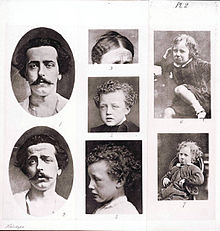
Motivation is the driving force of desire behind all deliberate actions of humans. Motivation is based on emotion—specifically, on the search for satisfaction (positive emotional experiences), and the avoidance of conflict. Positive and negative is defined by the individual brain state, which may be influenced by social norms: a person may be driven to self-injury or violence because their brain is conditioned to create a positive response to these actions. Motivation is important because it is involved in the performance of all learned responses. Within psychology, conflict avoidance and the libido are seen to be primary motivators. Within economics, motivation is often seen to be based on incentives; these may be financial, moral, or coercive. Religions generally posit divine or demonic influences.
Happiness, or the state of being happy, is a human emotional condition. The definition of happiness is a common philosophical topic. Some people might define it as the best condition that a human can have—a condition of mental and physical health. Others define it as freedom from want and distress; consciousness of the good order of things; assurance of one's place in the universe or society.
Emotion has a significant influence on, or can even be said to control, human behaviour, though historically many cultures and philosophers have for various reasons discouraged allowing this influence to go unchecked. Emotional experiences perceived as pleasant, such as love, admiration, or joy, contrast with those perceived as unpleasant, like hate, envy, or sorrow. There is often a distinction made between refined emotions that are socially learned and survival oriented emotions, which are thought to be innate. Human exploration of emotions as separate from other neurological phenomena is worthy of note, particularly in cultures where emotion is considered separate from physiological state. In some cultural medical theories emotion is considered so synonymous with certain forms of physical health that no difference is thought to exist. The Stoics believed excessive emotion was harmful, while some Sufi teachers felt certain extreme emotions could yield a conceptual perfection, what is often translated as ecstasy.
In modern scientific thought, certain refined emotions are considered a complex neural trait innate in a variety of domesticated and non-domesticated mammals. These were commonly developed in reaction to superior survival mechanisms and intelligent interaction with each other and the environment; as such, refined emotion is not in all cases as discrete and separate from natural neural function as was once assumed. However, when humans function in civilized tandem, it has been noted that uninhibited acting on extreme emotion can lead to social disorder and crime.
Culture
| Human society statistics | |
|---|---|
| World population | 7.1 billion |
| Population density | 12.7 per km² (4.9 mi²) by total area 43.6 per km² (16.8 mi²) by land area |
| Largest agglomerations | Beijing, Bogotá, Buenos Aires, Cairo, Delhi, Dhaka, Guangzhou, Istanbul, Jakarta, Karachi, Kinshasa, Kolkata, Lagos, Lima, London, Los Angeles, Manila, Mexico City, Moscow, Mumbai, New York City, Osaka, Paris, Rio de Janeiro, São Paulo, Seoul, Shanghai, Shenzhen, Tehran, Tianjin, Tokyo, Wuhan |
| Most widely spoken native languages | Mandarin Chinese, Spanish, English, Arabic, Hindi, Bengali, Portuguese, Russian, Japanese, German, Javanese, Punjabi, Telugu, Vietnamese, French, Marathi, Turkish, Korean, Tamil, Italian, Urdu, Indonesian |
| Most popular religions | Christianity, Islam, Hinduism, Buddhism, Sikhism, Judaism, Baha'i |
| GDP ( nominal) | $36,356,240 million USD ($5,797 USD per capita) |
| GDP ( PPP) | $51,656,251 million IND ($8,236 per capita) |
Humans are highly social beings and tend to live in large complex social groups. More than any other creature, humans are adept at utilizing systems of communication for self-expression, the exchange of ideas, and organization, and as such have created complex social structures composed of many cooperating and competing groups. Human groups range from families to nations. Social interactions between humans have established an extremely wide variety of values, social norms, and rituals, which together form the basis of human society.
Culture is defined here as patterns of complex symbolic behavior, i.e. all behaviour that is not innate but which has to be learned through social interaction with others; such as the use of distinctive material and symbolic systems, including language, ritual, social organization, traditions, beliefs and technology.
Language
The human capacity to exchange information and ideas through speech (and recently, writing) is unparalleled in other species. Unlike the closed sign systems of other primates in which sounds are unique and mutually exclusive, human language is open — an infinite number of meanings can be produced by combining a limited number of sounds and words. Human language also has the capacity of displacement, using words to represent things and happenings that are not presently or locally occurring, but reside in the shared imagination of interlocutors. Basic displacement may occur in other species, but is uniquely elaborated in humans, allowing symbols and language to refer to abstract or even purely imaginary states, and underpinning the complex symbolic culture of the species. Humans are the only species able to ask questions. Unlike chimpanzees and bonobos, who are able to answer complex questions but can not formulate and ask questions themselves, humans ask questions from a very early age. Human language is also unique in being a modality independent sign system, the same meanings can be conveyed through different media, auditively in speech, visually by gestural signs or writing and even through tactile media such as braille. The faculty of language is a defining feature of humanity, and a cultural universal. Language is central to the communication between humans, and to the sense of identity that unites nations, cultures and ethnic groups. The invention of writing systems at least five thousand years ago allowed the preservation of language on material objects, and was a major technological advancement. The science of linguistics describes the structure and function of language and the relationship between languages. There are approximately six thousand different languages currently in use, including sign languages, and many thousands more that are extinct.
Gender roles
The sexual division of humans into male and female has been marked culturally by a corresponding division of roles, norms, practices, dress, behaviour, rights, duties, privileges, status, and power. Cultural differences by gender have often been believed to have arisen naturally out of a division of reproductive labor; the biological fact that women give birth led to their further cultural responsibility for nurturing and caring for children. Gender roles have varied historically, and challenges to predominant gender norms have recurred in many societies.
Kinship
All human societies organize, recognize and classify types of social relationships based on relations between parents and children ( consanguinity), and relations through marriage ( affinity). These kinds of relations are generally called kinship relations. In most societies kinship places mutual responsibilities and expectations of solidarity on the individuals that are so related, and those who recognize each other as kinsmen come to form networks through which other social institutions can be regulated. Among the many functions of kinship is the ability to form descent groups, groups of people sharing a common line of descent, which can function as political units such as clans. Another function is the way in which kinship unites families through marriage, forming kinship alliances between groups of wife-takers and wife-givers. Such alliances also often have important political and economical ramifications, and may result in the formation of political organization above the community level. Kinship relations often includes regulations for whom an individual should or shouldn't marry. All societies have rules of incest taboo, according to which marriage between certain kinds of kin relations are prohibited - such rules vary widely between cultures. Some societies also have rules of preferential marriage with certain kin relations, frequently with either cross or parallel cousins. Rules and norms for marriage and social behaviour among kinsfolk is often reflected in the systems of kinship terminology in the various languages of the world. In many societies kinship relations can also be formed through forms of co-habitation, adoption, fostering, or companionship, which also tends to create relations of enduring solidarity.
Ethnicity
Humans often form ethnic groups, such groups tend to be larger than kinship networks and be organized around a common identity defined variously in terms of shared ancestry and history, shared cultural norms and language, or shared biological phenotype. Such ideologies of shared characteristics are often perpetuated in the form of powerful, compelling narratives that give legitimacy and continuity to the set of shared values. Ethnic groupings often correspond to some level of political organization such as the band, tribe, city state or nation. Although ethnic groups appear and disappear through history, members of ethnic groups often conceptualize their groups as having histories going back into the deep past. Such ideologies give ethnicity a powerful role in defining social identity and in constructing solidarity between members of an ethno-political unit. This unifying property of ethnicity has been closely tied to the rise of the nation state as the predominant form of political organization in the 19th and 20th century.
Society, government, and politics

Society is the system of organizations and institutions arising from interaction between humans. A state is an organized political community occupying a definite territory, having an organized government, and possessing internal and external sovereignty. Recognition of the state's claim to independence by other states, enabling it to enter into international agreements, is often important to the establishment of its statehood. The "state" can also be defined in terms of domestic conditions, specifically, as conceptualized by Max Weber, "a state is a human community that (successfully) claims the monopoly of the 'legitimate' use of physical force within a given territory."
Government can be defined as the political means of creating and enforcing laws; typically via a bureaucratic hierarchy. Politics is the process by which decisions are made within groups; this process often involves conflict as well as compromise. Although the term is generally applied to behaviour within governments, politics is also observed in all human group interactions, including corporate, academic, and religious institutions. Many different political systems exist, as do many different ways of understanding them, and many definitions overlap. Examples of governments include monarchy, Communist state, military dictatorship, theocracy, and liberal democracy, the last of which is considered dominant today. All of these issues have a direct relationship with economics.
Trade and economics
Trade is the voluntary exchange of goods and services, and is a form of economics. A mechanism that allows trade is called a market. The original form of trade was barter, the direct exchange of goods and services. Modern traders instead generally negotiate through a medium of exchange, such as money. As a result, buying can be separated from selling, or earning. The invention of money (and later credit, paper money and non-physical money) greatly simplified and promoted trade. Because of specialization and division of labor, most people concentrate on a small aspect of manufacturing or service, trading their labor for products. Trade exists between regions because different regions have an absolute or comparative advantage in the production of some tradable commodity, or because different regions' size allows for the benefits of mass production.
Economics is a social science which studies the production, distribution, trade, and consumption of goods and services. Economics focuses on measurable variables, and is broadly divided into two main branches: microeconomics, which deals with individual agents, such as households and businesses, and macroeconomics, which considers the economy as a whole, in which case it considers aggregate supply and demand for money, capital and commodities. Aspects receiving particular attention in economics are resource allocation, production, distribution, trade, and competition. Economic logic is increasingly applied to any problem that involves choice under scarcity or determining economic value.
War
War is a state of widespread conflict between states or other large groups of humans, which is characterized by the use of lethal violence between combatants and/or upon civilians. (Humans also engage in lesser conflicts, such as brawls, riots, revolts, and melees. A revolution may or may not involve warfare.) It is estimated that during the 20th century between 167 and 188 million humans died as a result of war. A common perception of war is a series of military campaigns between at least two opposing sides involving a dispute over sovereignty, territory, resources, religion, or other issues. A war between internal elements of a state is a civil war.
There have been a wide variety of rapidly advancing tactics throughout the history of war, ranging from conventional war to asymmetric warfare to total war and unconventional warfare. Techniques include hand to hand combat, the use of ranged weapons, Naval warfare, and, more recently, air support. Military intelligence has often played a key role in determining victory and defeat. Propaganda, which often includes information, slanted opinion and disinformation, plays a key role in maintaining unity within a warring group, and/or sowing discord among opponents. In modern warfare, soldiers and combat vehicles are used to control the land, warships the sea, and aircraft the sky. These fields have also overlapped in the forms of marines, paratroopers, naval aircraft carriers, and surface-to-air missiles, among others. Satellites in low Earth orbit have made outer space a factor in warfare as well as it is used for detailed intelligence gathering, however no known aggressive actions have been taken from space.
Material culture and technology
Stone tools were used by proto-humans at least 2.5 million years ago. The controlled use of fire began around 1.5 million years ago. Since then, humans have made major advances, developing complex technology to create tools to aid their lives and allowing for other advancements in culture. Major leaps in technology include the discovery of agriculture – what is known as the Neolithic Revolution, and the invention of automated machines in the Industrial Revolution.
Archaeology attempts to tell the story of past or lost cultures in part by close examination of the artifacts they produced. Early humans left stone tools, pottery, and jewelry that are particular to various regions and times.
Body culture
Throughout their history humans have altered their appearance by wearing clothing and adornments, by trimming or shaving hair or by means of body modifications.
Body modification is the deliberate altering of the human body for any non-medical reason, such as aesthetics, sexual enhancement, a rite of passage, religious reasons, to display group membership or affiliation, to create body art, shock value, or self-expression. In its most broad definition it includes plastic surgery, socially acceptable decoration (e.g., common ear piercing in many societies), and religious rites of passage (e.g., circumcision in a number of cultures).
Religion and spirituality
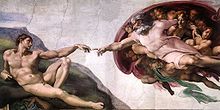

Religion is generally defined as a belief system concerning the supernatural, sacred or divine, and practices, values, institutions and rituals associated with such belief. Some religions also have a moral code. The evolution and the history of the first religions have recently become areas of active scientific investigation. However, in the course of its development, religion has taken on many forms that vary by culture and individual perspective. Some of the chief questions and issues religions are concerned with include life after death (commonly involving belief in an afterlife), the origin of life, the nature of the universe ( religious cosmology) and its ultimate fate ( eschatology), and what is moral or immoral. A common source for answers to these questions are beliefs in transcendent divine beings such as deities or a singular God, although not all religions are theistic. Spirituality, belief or involvement in matters of the soul or spirit, is one of the many different approaches humans take in trying to answer fundamental questions about humankind's place in the universe, the meaning of life, and the ideal way to live one's life. Though these topics have also been addressed by philosophy, and to some extent by science, spirituality is unique in that it focuses on mystical or supernatural concepts such as karma and God.
Although the exact level of religiosity can be hard to measure, a majority of humans professes some variety of religious or spiritual belief, although some are irreligious. Other humans have no religious beliefs or are atheists, scientific skeptics, agnostics or simply non-religious. Humanism is a philosophy which seeks to include all of humanity and all issues common to humans; it is usually non-religious. Most religions and spiritual beliefs are clearly distinct from science on both a philosophical and methodological level; the two are not generally considered mutually exclusive and a majority of humans hold a mix of both scientific and religious views. The distinction between philosophy and religion, on the other hand, is at times less clear, and the two are linked in such fields as the philosophy of religion and theology.
Philosophy and self-reflection
Philosophy is a discipline or field of study involving the investigation, analysis, and development of ideas at a general, abstract, or fundamental level. It is the discipline searching for a general understanding of reality, reasoning and values. Major fields of philosophy include logic, metaphysics, epistemology, philosophy of mind, and axiology (which includes ethics and aesthetics). Philosophy covers a very wide range of approaches, and is used to refer to a worldview, to a perspective on an issue, or to the positions argued for by a particular philosopher or school of philosophy.
Science and mathematics
Another unique aspect of human culture and thought is the development of complex methods for acquiring knowledge through observation and quantification. The scientific method has been developed to acquire knowledge of the physical world and the rules, processes and principles of which it consists, and combined with mathematics it enables the prediction of complex patterns of causality and consequence. Some other animals are able to recognize differences in small quantities, but humans are able to understand and recognize much larger, even abstract, quantities, and to recognize and understand algorithmic patterns which enables infinite counting routines and algebra, something that is not found in any other species.
Art, music, and literature

Art is a cultural universal, and humans have been producing artistic works at least since the days of Cro Magnon. As a form of cultural expression by humans, art may be defined by the pursuit of diversity and the usage of narratives of liberation and exploration (i.e. art history, art criticism, and art theory) to mediate its boundaries. This distinction may be applied to objects or performances, current or historical, and its prestige extends to those who made, found, exhibit, or own them. In the modern use of the word, art is commonly understood to be the process or result of making material works that, from concept to creation, adhere to the "creative impulse" of human beings. Art is distinguished from other works by being in large part unprompted by necessity, by biological drive, or by any undisciplined pursuit of recreation.
Music is a natural intuitive phenomenon based on the three distinct and interrelated organization structures of rhythm, harmony, and melody. Listening to music is perhaps the most common and universal form of entertainment for humans, while learning and understanding it are popular disciplines. There are a wide variety of music genres and ethnic musics. Literature, the body of written—and possibly oral—works, especially creative ones, includes prose, poetry and drama, both fiction and non-fiction. Literature includes such genres as epic, legend, myth, ballad, and folklore.
